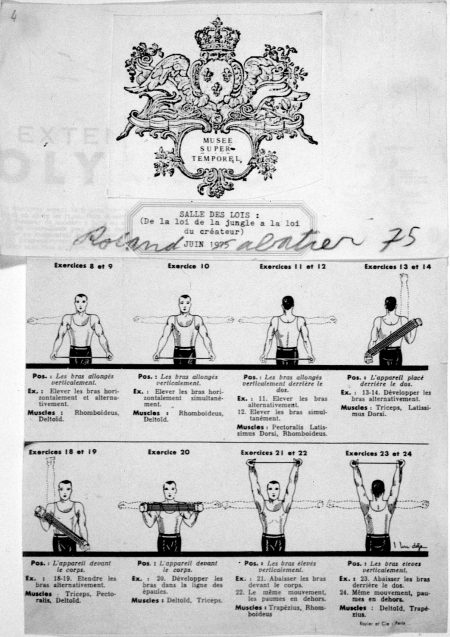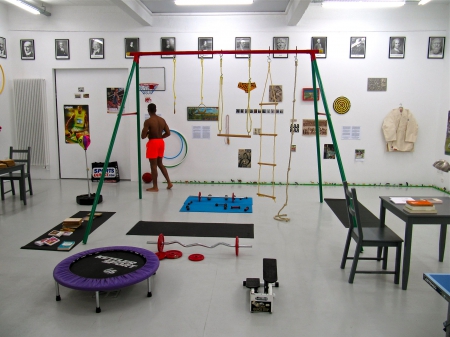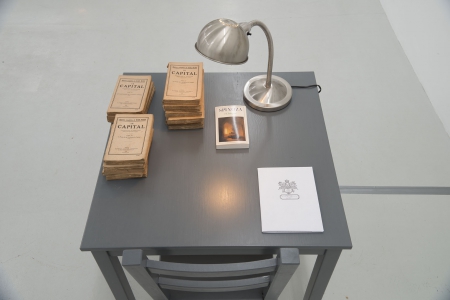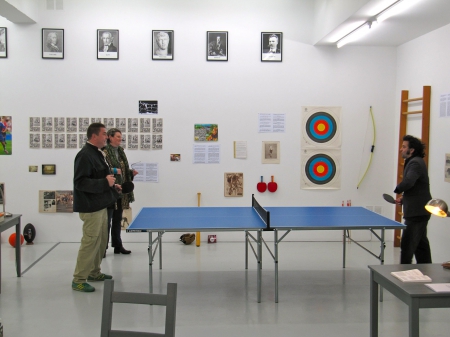From the Law of the Jungle to the Law of Creators. 1975
The general rhythm of this infinitesimal and supertemporal work is spread over three distinct sections, the components of which should preferably be offered to the public in three different rooms. If the premises are not big enough, it could be put on in three separate spaces of the same exhibition or presentation venue where the organisers have tried to create a sequence or direction for visitors.
Chapter I: This first chapter comprises 23 aesthapeirist ensembles which spectators will see on a wall, near the entrance, but on the edge of the positions in which the supertemporal expressions inscribed in the other sectors of this piece will later take place. These ensembles will be made up of identical hypergraphs joined with photographs, all more or less alike, showing an adult in front of a school blackboard, explaining to a child stories that figurines and reviews, scattered over the documents around the figures, clearly show to be about Tarzan and the Jungle.
Indifferent to their objective representation, these visible particles are put there to be surpassed in a transcendental and infinite way by a single mental image or, at a stretch, by a few more or less identical virtual expressions that the participants will be invited to create and then repeat, tirelessly, in a hermetic, tortuous and constantly deformed mono-rhythm, by the successive use of changing mechanisms or supports that are also imaginary, suggested by titles corresponding to each of the ensembles presented. The meanings and the colours of the letters and words composing these references will trigger chemical, physical, mechanical or cultural stimuli in spectators, whether real or imaginary, possible or impossible, destined to act at multiple degrees on all their author's senses.
Chapter 2: In a second position, this work will be completed by material comprising statuettes representing a march of wild beasts led by the hero of the jungle, and by various documents such as books, reviews, photographs and aural recordings relating to the story dreamed up by Edgar Rice Burroughs, and, by extension, sporting performances and scenes of violence taken from current events. These elements should be considered as so many independent aesthapeirist particles, destined to be organised in real or imaginary associations, in the context of the general work, for which they represent bases for reflection or infinitesimal themes that the author imposes on the participants and to which the latter will have to attribute different meanings in relation, for example, to the real, imaginary or even unimaginable possibilities of going beyond the acquired physical strength and the current limits of the human body by means of super-courage, technical enrichments or means, conceivable or otherwise, that are capable of contributing to the elimination of effort in human activity, or at least of reducing its effects, for intellectual and material rewards that are also inconceivable.
In addition, the exploration of this theme could possibly be extended on a rhetorical level by the organisation of a debate between views on the subject of ethics and laws. To this end, and with the aim of keeping discussion open and moving, the organisers of this event will make available to the public texts containing the essential ideas in this discipline, from Spinoza's Ethics to the positions of the Lettristes, and including the conceptions defined and taken up by the Surrealists.
Chapter 3: The last segment of this realisation consists of the presentation of a certain number of physical or intellectual exercises that viewers will be invited to perform in relation to the preparation, making or contemplation of invisible artistic works, whether accepted or refused.
By going beyond the usual limits of the sector of yield and anti-yield, the efforts made in relation to formal accomplishments can come to form an independent artistic structure.
By going beyond the respective frameworks of the categories of authors and viewers, these expressions will give rise to accomplishments in which the public, introduced as a simple supertemporal mechanism of any artistic sector, would endlessly carry out - by completing them or abandoning them or leaving so that other art-goers can take them up - any kind of real or imaginary efforts in relation or otherwise with all the fields of Knowledge and Life.
The required expressions will result from the deployment and utilisation of sporting or intellectual instruments such as bicycles, boxing gloves or gymnastic methods, pens and paper, etc., and all the materials, acquired or to be invented, real or imaginary, that participants will have thought to bring with them, or that the organisers will have made available to them in the actual places of the event.
As and when they arrive, the viewers, who have now become the makers of this supertemporal work, will take possession of their chosen supports to infinitely and unceasingly demonstrate their capacities - or incapacity, so little does it matter whether these exercises succeed or fail - in the field of the multiplication of the power of the body and the spirit.
APHONISTIC INTERMEZZO. In the aim of enriching this event with all the rhythms that are offered to it, it is desirable - notably so as to reinvigorate the action of the public - that the organisers and viewers best informed of the rhythms of art should perform an aphonistic intermezzo during which they will introduce versification into their supertemporal accomplishments.
Thus, in a profound silence, they may, at first, by means of a single instrument, translate different expenditures of energy, interspersed in determinate, regular or irregular quantities, with identical efforts recalling the fixed forms of classical poetry. Equally rigorous propositions would result from the use of different accessories and efforts repeated in particular rhythms to later attain exercises that are beautiful in themselves, performed with elegance and rigour, and not forgetting the accumulations of concentrated and hermetic expressions during which a single sporting action will be repeated and tortured ad infinitum, ending, after polyautomatic, irrational realisations, with a destructive or polythanasic phase made up of ridiculous or disdainful uses, of rejections of uses or only attempts at descriptions of possible uses of the proposed accessories and efforts.
Naturally, the failed or successful, visible, invisible or unimaginable expressions - such as fatigue, sweat, quickening breath, the workings of the muscles, their elasticity, etc. and even the heat given off, not to mention the effects on the circulation of the blood, on nutrition and the nervous system - will in turn have to be surpassed for other meanings or used, like imaginary materials, to fix acquired or future aesthetic forms.
Roland Sabatier (Paris, 6 June 1975)
With the participation of



